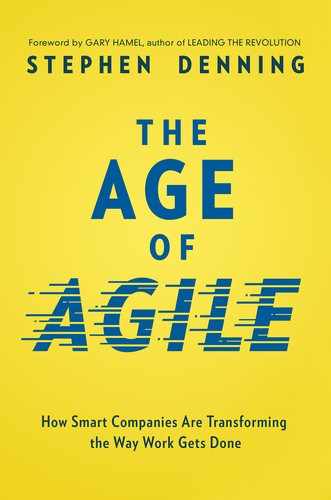More and more corporate leaders have responded with actions that can deliver immediate returns to shareholders, such as buybacks or dividend increases, while underinvesting in innovation, skilled workforces, or essential capital expenditures necessary to sustain long-term growth.
—LAURENCE FINK, chief executive of BlackRock Inc.1
It’s a familiar story. A famous global firm launches an Agile transformation, drawing on the energy and talents of bold pioneers who had been experimenting with Agile practices on their own. A C-suite executive endorses the initiative and large-scale training and coaching take place. Agile practitioners come out of the shadows and Agile management becomes part of the official life of the corporation. An Agile support team is appointed to orchestrate the initiative on a larger scale. The initiative gathers momentum as the people doing the work embrace the better way of getting things done. The faster pace of developing more value to customers is documented. Agile champions help spread the word across the organization.
The Agile initiative prospers for several years, until suddenly the C-suite declares victory. “We are Agile now,” the announcement goes. “Going forward, we will be taking a more disciplined approach to delivering shareholder value.”
Quiet protests ensue, but the axe comes down from above. The erstwhile sponsor in the C-suite is reassigned. The firm’s Agile champions are scattered or dismissed. Agile management now lacks official support in the firm and work becomes more rule-based and perfunctory. Morale suffers. Good staff members leave. Quality declines. Technical debt accumulates. Inexplicable system outages occur. Innovation grinds to a halt. After a few years, someone in the C-suite—often a newcomer—starts asking, “Why can’t we get anything done? Hasn’t anyone heard about Agile?” And so, the Agile transformation cycle begins again.2
The first part of this book (Chapters 1 through 7) dealt with the positive principles of Agile management. In this second part, Chapters 8 through 11 are dedicated to understanding why such cyclical setbacks occur and what can be done to prevent them.
The sad fact is that Agile management is at odds with much of what is practiced in public corporations and taught in business schools, even today. Generations of managers have built whole careers on different assumptions. If Agile management is to prosper in a sustainable way, leaders not only need to learn about Agile goals, principles, and practices. They also need to be aware of the beliefs, assumptions, and processes that they will have to unlearn.
Similarly, Agile leaders must recognize that they cannot proceed in a public corporation on the assumption that if teams do good work and delight their customers, they will in due course be recognized and rewarded. They need to understand what is going on elsewhere in the corporation, particularly those sections dealing with the financial aspects of management. The issues are not minor: They typically concern the very purpose of the corporation. In its crudest terms, the question is: Should the corporation be focusing on creating value for customers, or on extracting value for its shareholders and senior executives?
If Agile management is to thrive in an organization on a sustained basis, leaders need to understand why such a question has arisen, why it has become pervasive, and how it can be dealt with in a proactive fashion. In particular, corporations need to avoid four management traps:
![]() The trap of focusing the firm on maximizing shareholder value as reflected in the current stock price (Chapter 8)
The trap of focusing the firm on maximizing shareholder value as reflected in the current stock price (Chapter 8)
![]() The trap of manipulating the firm’s share price through share buybacks (Chapter 9)
The trap of manipulating the firm’s share price through share buybacks (Chapter 9)
![]() The trap of cost-oriented economics that focuses on short-term profits at the expense of customers and the sustainability of the corporation (Chapter 10)
The trap of cost-oriented economics that focuses on short-term profits at the expense of customers and the sustainability of the corporation (Chapter 10)
![]() The trap of backward-looking strategy that deduces the future from the past, rather than using abductive logic that derives the present from a different and more fruitful future (Chapter 11)
The trap of backward-looking strategy that deduces the future from the past, rather than using abductive logic that derives the present from a different and more fruitful future (Chapter 11)
